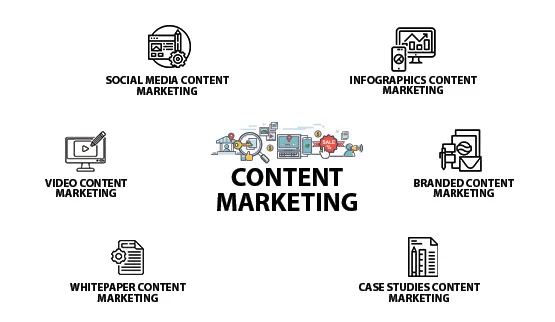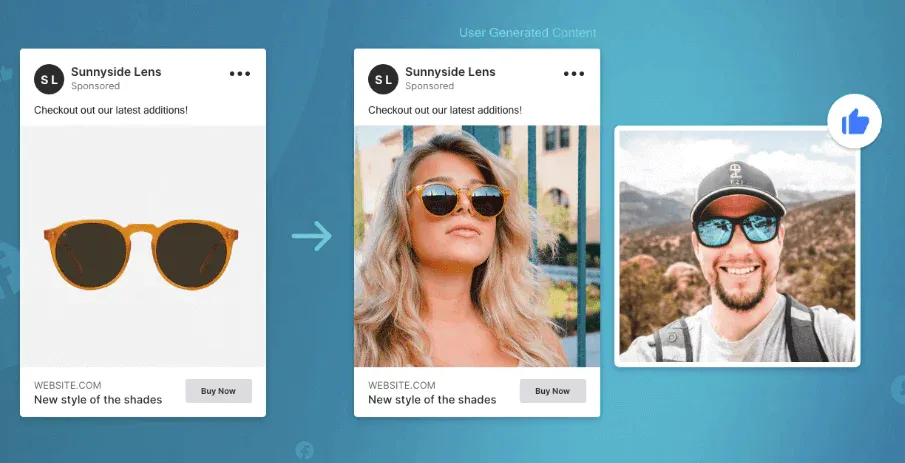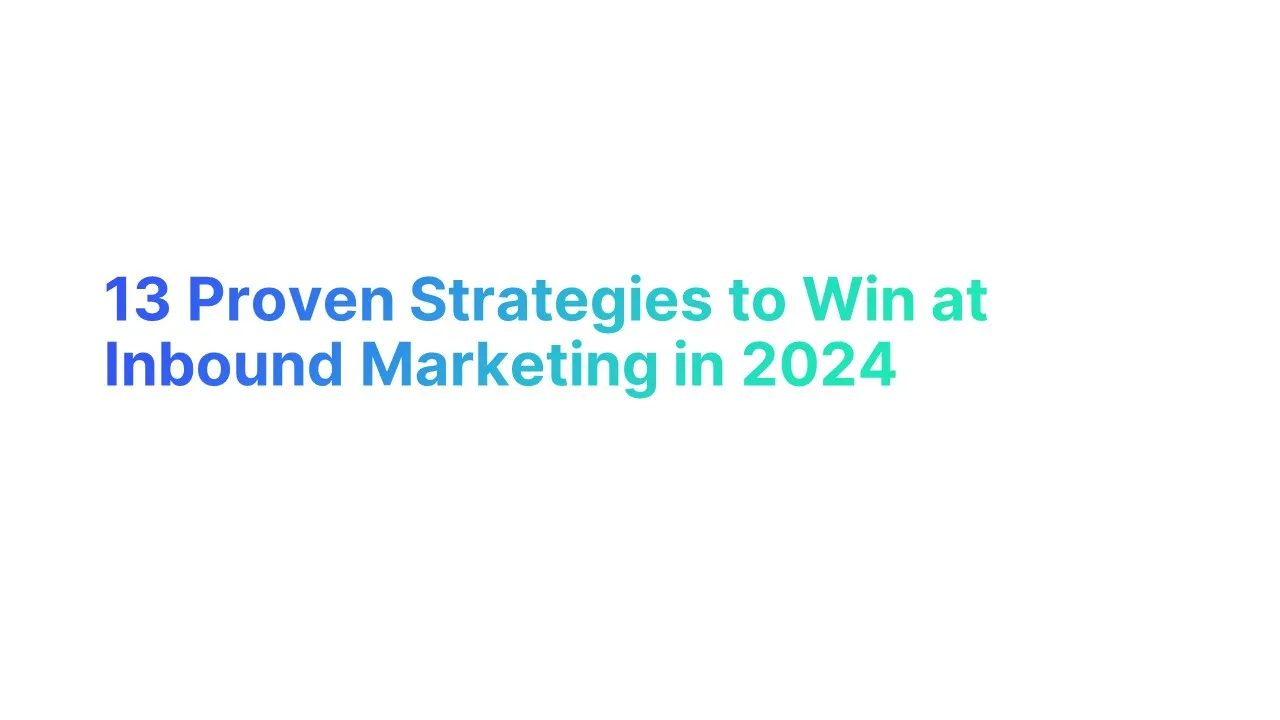Introduction to Inbound Marketing

What is Inbound Marketing
Inbound marketing is a powerful strategy aimed at drawing customers to products and services via content marketing, social media marketing, search engine optimization (SEO), and branding.
This approach differs fundamentally from traditional outbound marketing, prioritizing the creation of value for customers to attract them naturally.
Why is Inbound Marketing Important
Inbound marketing is important because it aligns with the way consumers make purchasing decisions today. By creating valuable content and experiences tailored to them, it attracts potential customers to a company or product. This approach is cost-effective, builds trust and credibility, and creates long-term relationships with customers.
Unlike traditional outbound marketing methods, which involve reaching out to consumers whether they are interested or not, inbound marketing focuses on making it easy for your target audience to find you when they need information, solutions, or products.
This leads to higher quality leads, improved customer satisfaction, and increased loyalty, ultimately contributing to a stronger brand and better sales results.
Inbound Marketing Methodology

The inbound marketing methodology can be broken down into three core stages: Attract, Engage, and Delight. Each stage is crucial for turning strangers into promoters of your brand.
Attract
Start with understanding your target audience's needs and challenges. Use this insight to create content that draws potential customers to your website.
- SEO: Implementing SEO strategies can increase organic traffic by up to 70%, as it optimizes your content to appear in relevant search results.
- Social Media: Platforms like LinkedIn and Twitter can boost your content's reach, attracting a broader audience by sharing insightful and engaging posts.
Engage
Once you've attracted visitors, the next step is to engage with them by providing solutions to their problems.
- Email Marketing: Personalized email campaigns have an average open rate of 20.81%, making them a powerful tool for engaging interested leads.
- Inbound Sales Leads: Nurturing leads with useful information can increase sales opportunities by over 20%, guiding potential customers further down the sales funnel.
Delight
The final step is to ensure customers are satisfied and turn them into advocates for your brand.
- Customer Support: Providing outstanding customer support can increase customer retention rates by up to 5%, significantly boosting profitability.
- Feedback Loops: Implementing customer feedback into your strategy ensures continuous improvement and helps maintain a positive brand image.
Inbound Marketing vs. Outbound Marketing: Key Differences and Benefits
18 Proven Inbound Marketing Strategies to Use in 2024
To execute a successful inbound marketing campaign, focus on these 18 top strategies
1. Optimize for Local SEO

Optimizing for local SEO is crucial for businesses that operate on a regional level. Unlike traditional SEO, local SEO places a higher emphasis on appearing in local search results, which is essential for attracting customers in your immediate area.
Local SEO leads have a high conversion rate, with Google reporting that 28% of local searches result in a purchase. This is because local SEO catches potential customers at the moment they are looking for your services or products.
How to implement
- Google My Business: Claim and optimize your Google My Business listing. Ensure your business name, address, and phone number (NAP) are consistent across all online platforms.
- Local Keywords: Incorporate local keywords into your website's metadata, headers, and content. Tools like Google Keyword Planner can help identify local keywords relevant to your business.
- Local Link Building: Encourage local customers to leave reviews and build backlinks from local directories, newspapers, and other local businesses.
2. Leverage LinkedIn for B2B Networking

LinkedIn has emerged as a powerhouse for B2B networking, enabling businesses to connect directly with industry peers, potential clients, and thought leaders.
LinkedIn is the top-rated social network for lead generation in the B2B sector.
With over 700 million professionals, it offers a vast network for establishing partnerships, generating leads, and building brand authority.
How to implement
- Optimized Company Page: Create an optimized LinkedIn Company Page that reflects your brand’s identity, showcases your products or services, and highlights your achievements.
- Content Marketing on LinkedIn: Publish insightful articles, share industry news, and participate in relevant discussions. According to LinkedIn, 80% of B2B leads generated through social media come from LinkedIn.
- LinkedIn Ads: Utilize LinkedIn’s advanced targeting features to run ads focused on professionals who fit your target customer profile. Tailor your messaging to address their specific needs and pain points.
3. Implement Live Chat on Your Site

Implementing live chat on your website provides immediate assistance to visitors, answering their queries in real-time and guiding them through their buyer's journey. It's an effective tool to increase engagement and conversion rates.
Live chat significantly enhances customer service and support, leading to increased satisfaction.
How to implement
- Choose the Right Software: Select a live chat software that integrates seamlessly with your website and offers the features that best suit your business needs, such as automated greetings, chat history, and offline messages.
- Train Your Team: Ensure your team is trained to respond promptly and effectively. Use canned responses for common questions to speed up reply times without compromising the quality of service.
- Analyze Chat Histories: Regularly review chat transcripts to identify common questions or issues. Use this data to improve your website's FAQ section, product information, or content strategy.
4. Create Interactive Landing Pages

Interactive landing pages engage visitors by encouraging them to interact with the content, rather than passively consuming it. This can include quizzes, calculators, assessments, or interactive videos.
Interactive elements on landing pages can significantly increase engagement and conversion rates. They provide value to the visitor by offering personalized results or insights, making them more likely to leave their contact information or make a purchase.
According to Demand Metric, interactive content can generate conversions moderately or very well 70% of the time, compared to 36% for passive content.
How to implement
- Understand Your Audience: Before designing an interactive landing page, understand your audience’s preferences, needs, and pain points. This ensures that the interactive elements are relevant and valuable to your visitors.
- Use the Right Tools: Leverage tools and platforms designed for creating interactive content, such as Outgrow or LeadQuizzes. These can help you design, implement, and track the performance of your interactive elements without extensive coding knowledge.
- A/B Testing: Always test different versions of your interactive landing pages to see what works best. Experiment with different types of interaction, layouts, and calls-to-action (CTAs) to optimize for the highest conversion rates.
5. Use Retargeting Strategies
Retargeting strategies are a form of online advertising that targets users who have previously visited your website but didn’t convert. By reminding them of your products or services, retargeting helps increase conversion rates and keeps your brand top of mind.
Retargeting is crucial because it focuses on people who have already shown interest in your products or services.
The click-through rate (CTR) of a retargeted ad is 10 times higher than that of a typical display ad, according to Wishpond, making it a highly efficient way to drive sales.
How to implement
- Segment Your Audience: Create different retargeting campaigns for different segments of your audience based on their behavior on your site. For example, you might target users who added items to their cart but didn't purchase differently from those who only viewed a product page.
- Choose the Right Platform: Use platforms like Google Ads and Facebook for retargeting, as they offer extensive reach and sophisticated targeting options. Tailor your ad creative to match the specific interests and interactions of each segment.
- Monitor and Optimize: Regularly review the performance of your retargeting campaigns. Test different ad creatives, messages, and calls to action to find the most effective combinations.
6. Develop a Strong Content Marketing Strategy

A strong content marketing strategy focuses on creating and distributing valuable, relevant, and consistent content to attract and retain a clearly defined audience. The goal is to drive profitable customer action by providing content that solves problems or meets needs.
Effective and relevant content marketing establishes your brand as a thought leader in your industry, builds trust with your audience, and improves SEO by generating inbound links and increasing dwell time on your site.
Companies that blog regularly generate 67% more leads per month than those that do not, according to HubSpot.
How to implement
- Understand Your Audience: Conduct audience research to understand the needs, problems, and questions of your target customers. Use this information to create content that addresses these points.
- Create a Content Calendar: Plan your content in advance with a content calendar. This should include a mix of formats such as blog posts, videos, infographics, and podcasts, aligned with key dates, product launches, or industry events.
- Promote Your Content: Creating great content is just the first step; promoting it is equally important. Use social media, email newsletters, and your personal network to share your content. Consider leveraging guest posting and content syndication to reach wider audiences.
- Measure Success: Use analytics tools to track the performance of your content. Key metrics include website traffic, engagement rates, lead generation, and conversion rates. Use these insights to refine your strategy over time.
7. Embrace Video Marketing on YouTube

YouTube stands as the second largest search engine and offers a vast platform for video marketing. By creating engaging video content, you can significantly increase your brand’s visibility and engage with a wider audience.
How to implement
- Create Quality Content: Focus on producing high-quality videos that offer value to your target audience. This could include how-to guides, product reviews, customer testimonials, or behind-the-scenes looks at your company.
- Optimize for Search: Use relevant keywords in your video titles, descriptions, and tags to ensure they are discoverable on YouTube and Google. Engaging thumbnails can also increase your click-through rates.
- Promote Your Videos: Share your YouTube videos on your website, social media channels, and email newsletters to maximize their reach. Encourage viewers to subscribe to your channel and share your videos to grow your audience organically.
- Analyze and Adapt: Utilize YouTube Analytics to track the performance of your videos. Look at metrics like watch time, traffic sources, and audience demographics to refine your content strategy over time.
8. Host Virtual Events
Virtual events have become a crucial part of digital marketing strategies, offering a way to engage with your audience in real time, regardless of geographical barriers.
How to implement
- Choose the Right Platform: Select a virtual event platform that suits the size and style of your event, whether it’s a webinar, live Q&A session, or virtual conference. Consider features like chat functionality, Q&A, polling, and breakout rooms.
- Promote Your Event: Use your website, social media, email marketing, and other channels to promote your event. Create compelling event descriptions and highlight the value attendees will gain by participating.
- Engage Your Audience: During the event, encourage participation through live polls, Q&A sessions, and interactive workshops. This not only makes the experience more engaging for attendees but also provides valuable feedback for your brand.
- Follow Up: After the event, follow up with attendees via email with key takeaways, additional resources, and a call to action. This helps maintain the momentum of engagement and can guide leads further down the sales funnel.
9. Utilize User-Generated Content on Social Media

User-Generated Content (UGC) on social media involves encouraging your customers to share their own experiences, photos, videos, reviews, or testimonials related to your brand. This content can then be shared on your own social media channels, websites, or other marketing platforms.
UGC acts as social proof, building trust and credibility with potential customers.
This type of content can significantly boost engagement, increase brand loyalty, and enhance your overall marketing strategy.
How to implement
- Encourage Sharing: Create campaigns or incentives that motivate customers to share their experiences with your brand on social media. This could be through contests, hashtags, or simply asking for their stories.
- Showcase UGC: Feature user-generated content prominently on your social media profiles, website, or in your marketing materials. Make sure to always ask for permission and give credit to the original creators.
- Engage with Contributors: Actively engage with users who post content about your brand by liking, commenting, and sharing their posts. This not only amplifies the reach of UGC but also fosters a community around your brand.
- Monitor and Measure: Use social media monitoring tools to track the reach and engagement of UGC. This data can inform your strategy and help you identify the most effective types of content.
10. Publish Original Research and Data
Publishing original research and data involves conducting studies, surveys, or analyses that produce new insights relevant to your industry. This content can then be shared through reports, blog posts, infographics, or other formats to attract attention and establish your brand as a thought leader.
Original research provides value that can't be found elsewhere, setting your brand apart in a crowded market. It can attract significant attention from your target audience, industry peers, and the media, leading to increased visibility, backlinks, and authority.
How to implement
- Identify a Unique Angle: Look for gaps in existing research or emerging trends that your brand can uniquely address. This could involve analyzing internal data or surveying your audience.
- Conduct Thorough Research: Ensure your methodology is solid and your data is reliable. Partnering with industry experts or research firms can add credibility to your findings.
- Present Your Findings Effectively: Create compelling, accessible content that presents your research findings in a clear and engaging way. Utilize visuals, summaries, and actionable insights to make your data approachable.
- Promote Widely: Share your research across all available channels—your website, social media, email newsletters, and through press releases. Consider creating different content formats, like webinars or podcasts, to discuss your findings in depth.
11. Offer Free Tools or Resources
Offering free tools or resources such as calculators, templates, or software trials provides immediate value to your audience, helping to attract leads and build trust with potential customers.
Providing something of value for free can significantly enhance your brand’s perceived value and authority.
It not only aids in lead generation by encouraging users to provide their contact information in exchange for the tool but also increases loyalty as users are likely to remember and appreciate the brand that helped them solve a problem or achieve a goal.
How to implement
- Identify Your Audience’s Needs: Understand the challenges your target audience faces and develop tools or resources that address those needs directly.
- Easy Access and Usability: Ensure that the tools or resources you offer are easy to use and accessible. Consider a simple signup process that captures essential lead information without being overly intrusive.
- Promote Across Channels: Use your website, social media, email marketing, and other channels to promote your free offerings. Highlight the value and potential outcomes of using your tools or resources.
- Gather Feedback and Iterate: Collect feedback from users to improve your offerings. Regular updates based on user input can enhance the tool's value over time, encouraging repeat visits and shares.
12. Optimize Website Speed and User Experience

Optimizing your website’s speed and overall user experience (UX) is critical for keeping visitors engaged and reducing bounce rates.
A website that loads quickly and offers an intuitive user interface encourages visitors to stay longer and explore more content, which can lead to higher conversion rates.
How to implement
- Perform a Site Audit: Use tools like Google PageSpeed Insights to identify areas where your website can be optimized for better speed and performance.
- Improve Loading Times: Minimize HTTP requests, enable compression, optimize images, and leverage browser caching to improve loading times.
- Enhance UX: Ensure your website is easy to navigate, mobile-friendly, and accessible. Simplify your design, use clear calls-to-action (CTAs), and ensure your content is easily readable.
- Monitor and Iterate: Continuously monitor your website’s performance and user feedback. Use this data to make ongoing improvements to both speed and UX.
13. Create a Referral Program
A referral program incentivizes your existing customers to recommend your products or services to their network. By rewarding both the referrer and the referred, you can significantly expand your customer base and increase loyalty.
How to implement
- Design an Attractive Offer: Determine what rewards will be most appealing to your current customers and their referrals. This could be discounts, free products, or other incentives.
- Make it Easy to Share: Ensure that sharing your referral program is as easy as possible. Provide a simple referral link that customers can send to friends and family or share on social media.
- Promote Your Program: Utilize your website, social media channels, and email marketing to spread the word about your referral program. Highlight the benefits and rewards of participating.
- Track and Optimize: Monitor the performance of your referral program using tracking codes or referral software. Analyze which incentives work best and adjust your strategy accordingly to maximize participation and conversion
How to Measure Your Inbound Marketing Efforts

To measure your inbound marketing efforts effectively, focus on these key metrics:
Traffic: Track the number of visitors to your website and where they come from (organic search, social media, referrals, etc.) to understand which channels are most effective.
Leads: Monitor the number of new leads generated. Analyze which sources bring in the most leads to optimize your strategy.
Conversion Rate: Calculate the percentage of visitors who become leads and then customers. This tells you how effectively you're turning interest into action.
Customer Acquisition Cost (CAC): Determine how much you spend on acquiring a new customer. Lowering the CAC while maintaining quality leads is a primary goal.
Customer Lifetime Value (CLV): Assess the total revenue a customer will bring over their lifetime. Aim to increase CLV through effective inbound marketing and customer retention strategies.
ROI: Measure the return on investment by comparing the revenue generated from inbound marketing to the costs of your inbound marketing activities.
Engagement: Track how engaged your audience is with your content through metrics like page views, time on site, and social media interactions. Higher engagement often correlates with higher conversion rates.
Final Thoughts on Implementing Your Inbound Marketing Strategy in 2024
To execute an effective inbound marketing strategy, it's crucial to blend marketing automation with a mix of inbound and outbound marketing tactics. This approach ensures that you’re not only attracting your target audience with valuable content but also engaging them through personalized, automated follow-ups.
Marketing automation plays a pivotal role in streamlining these processes, allowing for more efficient lead nurturing and conversion. By thoughtfully integrating these elements, you can sharpen your marketing efforts, making your strategy more dynamic and results-driven.
Remember, the key to success lies in how well you align your inbound marketing tactics with the needs and preferences of your audience, ensuring that every interaction adds value and builds trust.





.png)

